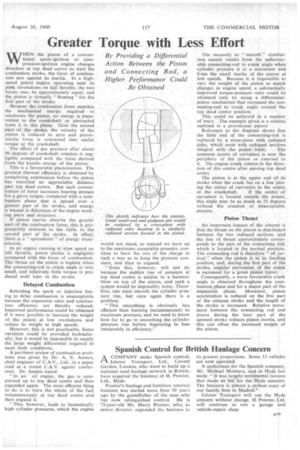Greater Torque with Less Effort
Page 73

If you've noticed an error in this article please click here to report it so we can fix it.
By Providing a Differential Action Between the Piston and Connecting Rod, a Higher Performance Could
WTHEN the piston of a conventional spark-ignition • or cornpression4gnition engine changes direction at top dead centre• to start the combustion stroke, the force of combustion acts against its inertia. In .a highspeed petrol engine operating near its peak revolutions on full throttle, the two fcirces may be approximately equal, and the piston is virtually "floating' for the
first part of the stroke. '
Because the combustion force. matches the mechanical energy required to accelerate the piston no energy is transmitted to the crankshaft _ or abstracted from it in this Phase. Over the second part of the stroke, the velocity of the•piston is reduced to zero and piston
• inertia force is converted into useful torque at the crankshaft.
The effect of gas pressure after about 90 degrees of crankshaft rotation is negligible compared with the force derived .:from the kinetic energy of the piston.
This is-a favourable phenomenon. The greatest thermal efficiency is obtained by completing combustion before the piston has travelled an appreciable •distance past top dead centre. But such concentration of force increases bearing stresses for a given torque, compared with a.combustion phase . that is Spread over a greater part of the stroke, and energy is wasted in distortion of the engine working parts and structure. . If pistoninertia absorbs the greater part of the combustion force, this is pro-. gressivelyrestored to the 'cycle in the second part of the stroke. In effeet, there is a ':''spieadovcr ".Of,eitergy trans_ mission.
titan engine running at slow speed on full throttle; piston inertia is negligible compared with the force of combustion. The thrust on the piston. is highest when the_connecting-rod to crank. angle is very small, and relatively little torque is produced until later in the stroke.
Delayed Combustion
Retarding the spark or injection timing to delay combustion is unacceptable because the expansion ratio and combustion efficiency arc thereby reduced. Improved performance could be obtained if it were possible to increase the weight of the piston at low revolutions and reduce its weight at high speeds.
However, this is not practicable. Some variation could be provided hydraulically, but it would be impossible to supply the large weight 'differential required to meet both conditions.
A pertinent review of combustion problems was given by Dr. A. E. Austen, chief engineer of C.A.V., Ltd., in a paper read at a recent C.A.V. agents' conference. Dr. Austen stated: "In an oil engine, the gas is compressed up to top dead centre and then expanded again. The most efficient thing to do is to burn the whole of the fuel instantaneously at top dead centre and then expand it.
"This, however, leads to fantastically high cylinder pressures, which the engine would not stand, so instead we burn up to the maximum acceptable pressure, continue to burn the rest of the charge in such a way as to keep the pressure constant, and then to expand.
"Even this, however, will not do because the sudden rise of pressure at top dead centre is similar to a hammer blow on top of the piston, and such a system would be impossibly noisy. Therefore, one Must smooth the cylinder pressure rise, but once again there is a problem.
"This smoothing is obviously less efficient than burning instantaneously to maximum pressure, and we need to know how far to go in smoothing the cylinder pressure rise before beginning to lose intolerably in efficiency."
The necessity to "smooth " combustion mainly results from the unfavourable connecting-rod to crank angle when cylinder pressure is at a maximum and from the small inertia of the piston at low speeds. Because it is impossible to vary the' weight of the piston to match changes in engine speed, a substantially improved torque-pressure ratio could be obtained only by using a differentialpiston mechanism that increased the connecting-rod to crank angle around the top dead centre position.
This could be achieved in a number of ways.' The example given is a scheme outlined in a provisional patent, Reference to the diagram shows that the little end of the connecting-rod is replaced by a cross-picce with radiused sides, which mate with radiused sections integral with the piston body. The commoo centre of curvature is near the periphery of the piston or external to it. The. engine crank rotates in the direc lion of this centre after passing top dead centre.
The piston is at the upper end of its stroke when the crank lies on a line joining the centre of curvature to the centre
of the crankshaft. 'If the centre of curvature is located outside the piston, this angle may be as much as 25 degrees, without the creation Of unaCceptable stresses. .
Piston Thrust
An important feature of the scheme is that the thrust on the piston is distributed between the two radiused sections, and the line of thrusf,approximately caries
ponds to the axis of the connecting rod, which is located in the normal positicin. The connecting rod is therefore "off ver-• tint " when, the piston is in its limiting pOsitiOn, and, during the first part of the stroke,. angular movement. of the crank is increased for a given piston travel.'
Consequently, a more favourable crank angle is obtained throughout the combustion,phase and for a major part of the expansion phase. Moreover, piston acceleration is reduced on the first part of the exhaust stroke and the length of the stroke is increased. Relative movement between the connecting rod and piston during the later part of the upward stroke reduces piston inertia, and this can offset the increased weight of the piston.




















































































































